Saturday, May 7, 2022
Williams Center for the Arts
Program and Program Notes
Giovanni Gabrielli (1554-1612)
Sonata Pian’e Forte (1597)
Transcribed by Kirk O’Riordan
First published in 1597, the Sonata Pian’e Forte was among the first known works to incorporate instructions for playing passages at loud and soft dynamic levels. The term “sonata” here refers to a purely instrumental work, and this one was composed for two groups of four (brass) instruments that were to be spatially separated from each other. Indeed, many of Gabrielli’s works incorporate antiphony, and in this piece the original design created both “left and right” antiphony, but also “loud and soft” antiphony.
When writing this transcription, I seriously considered dividing the band in half and putting one group in the balcony. While that would have been fun (and we have done that on several occasions before), I chose instead to create the antiphonal effects with orchestral color. There are sections (especially those in the soft dynamic range) that change instrument combinations to create the sense of distance. I gave the piano passages to the winds, and featured the brass and tutti textures in the forte sections.
—
Giovanni Pierluigi da Palestrina (1525-1594)
Missa Papae Marcelli (1562)
Transcribed by Kirk O’Riordan
I. Kyrie
II. Gloria in excelsis deo
Widely considered Palestrina’s best work, the Pope Marcellus Mass stands as an archetype of the style of complex modal counterpoint championed by its composer. Legend has it that this piece, when performed for church leaders who at the Council of Trent were deciding the fate of polyphony in the liturgical music of the time, “saved” polyphony from exile. While this is not entirely historically accurate, listening to the piece makes it easy to believe that it could have been: the counterpoint in this piece is simply stunning; the overall mood is reverent and prayerful.
The original version was composed for six voices (a seventh is added in the final movement). Our performance does not include the text, though the complexity and consistency of the counterpoint make the text very difficult to hear. The challenge in arranging this for winds and brass (there are no percussion parts in this transcription) was to maintain the integrity of the melodic lines while distributing the lines among the instruments and keeping the balances in tact. Another difficulty is that the pitches in Palestrina’s score span just two octaves and are all right in the middle of the piano’s range. Some spreading of the texture was necessary to put lines in ranges that were comfortable for certain instruments.
In the Kyrie, I gave the first section (“Kyrie eleison”) to the winds, the middle section (“Christe eleison”) to the brass, and the final section (“Kyrie eleison”) to the full band. I continued the idea of using consorts of instruments in the Gloria, and because there is less internal architecture in this movement than in the Kyrie, I was able to mix the winds and brass instruments more liberally.
—
Tielman Susato (c. 1515 – c. 1570)
Selections from The Danserye (1551)
Transcribed by Patrick Dunnigan
I. La Morisque
II. Bergerette
III. Les quatre Branles
V. Den hoboecken dans
VI. Ronde & Salterelle
VII. Ronde & Aliud
IX. Pavanne: La Battaille
Selections from “The Danserye” is a new setting for wind band consisting of nine dances fashioned into an extended symphonic suite. The arrangement utilizes the full resources of the modern wind band, featuring various sections (or consorts of instruments) in alteration with powerful tutti passages. While the wind parts remain faithful to the original material, the dances are energized with a healthy dose of contemporary percussion effects and a significant part for acoustic guitar. This blend of sound generates a new but familiar element, thus making something very modern out of music that is more than 450 years old.
The Danserye is a set of instrumental dances based on popular tunes of the time, arranged by Susato and published in 1551 as Het derdemusyckboexken. With more than 50 individual dances in a variety of forms, the collection is notable for its simple textures and strict homophony. Specific instrumentation is not indicated, thus suggesting that the tunes were performed by whatever combination of winds and strings was available.
The arrangement was created for the Florida State University Symphonic Band and was premiered on April 17, 2002. The professional premiere by the Dallas Wind Symphony, Jerry Junkin conducting, was on November 19, 2002, at the Meyerson Symphony Center in Dallas, Texas. (Notes by Patrick Dunnigan)
Conductor’s Note: These pieces are in many ways the polar opposite of the two previous pieces–this is especially true for the Palestrina. These are secular dances used in social gatherings; they are strictly strophic forms as opposed to the text-centered through-composed nature of the Mass movements; in style they are light in energetic rather than cerebral and spiritual. Each dance features several variations of two or three distinct melodic sections, and Dunnigan creates contrast by continually varying the orchestration, often alternating between thick and thin scoring.
—
Kirk O’Riordan (b. 1968)
I Dwell in Possibility (2021)
Poem by Emily Dickinson (1862)
I Dwell in Possibility was composed in celebration of the Inauguration of Nicole Farmer Hurd, 18th President of Lafayette College. It was performed at her formal installation on Friday, October 1, 2021 by the Lafayette College Concert Band and the Lafayette College Concert Choir, under my direction.
The poem, by Emily Dickinson, speaks of the infinite opportunities presented by poetry—where one is limited only by one’s imagination. I found this to be an appropriate metaphor for a new college president: the promise of achievement and success that comes with a new beginning.
The piece hopes to depict the state of reverie one might feel at the moment one discovers what is possible. It is a day dream—a trance-like vision of what can be to come; the feeling of euphoria that arises from the intersections of skill, hard work, confidence, and imagination.
Dickinson’s poetry:
I dwell in Possibility –
A fairer House than Prose –
More numerous of Windows –
Superior – for Doors –
Of Chambers as the Cedars –
Impregnable of eye –
And for an everlasting Roof
The Gambrels of the Sky –
Of Visitors – the fairest –
For Occupation – This –
The spreading wide my narrow Hands
To gather Paradise –
Special thanks to the members of the Easton Area High School choirs and wind ensemble, and their outstanding directors Christopher Ballentine (bands) and Pete Deshler (choirs). It is a thrill to have them join us this evening. The EAHS ensembles performed this work on their program three days ago, and they have given so much of their time and energy to making these performances happen.
The Easton Area High School Concert Choir
The Easton Area High School Concert Choir is an un-auditioned SATB ensemble available to all students enrolled at Easton Area High School. The choir performs a varied repertoire from different time periods and genres for school and community functions, competitions and concerts. The Concert Choir has performed in Baltimore, Boston, Chicago, Cleveland, Myrtle Beach, Toronto, Virginia Beach, and Washington D.C. The Easton Area School District has received the NAMM Best Communities for Music Education recognition for the last three years.
—
Charles Ives (1874 – 1954)
Variations on “America” (1891, 1968)
Transcribed by William E. Rhoads from an orchestral transcription by William Schuman
Charles Ives was the son of a Civil War band leader who imparted to his young son a unique and startlingly fresh musical imagination. Having grown up in a family environment in which American folk music flourished, Ives soon developed an interest in incorporating this music into his work. He would do so, though, in unconventional ways. For example, it was not uncommon for Ives to set two (or more) melodies simultaneously, in different keys and in different meters. The result is the musical equivalent of the “collage” technique in art.
Variations on “America” was originally composed for organ when Ives was 17. It is easy to succumb to the temptation to view this piece as youthful sarcasm, though one should resist this urge. These were serious attempts at studying variation techniques, and if one is familiar with variation sets by Mozart, Beethoven, Brahms, and the like, one will hear many of the same devices: presenting the theme in the parallel minor, rhythmic ornamentation, and other common techniques. Ives adds to these a propensity to set the tune against itself–sometimes using two or more keys at the same time while metrically displacing two opposing presentations of the tune. It is a surprisingly sophisticated work given the composer’s young age: it certainly serves as something of a prototype for Ives’ later, more adventurous works.
Conductor’s Note: Conducting “Variations on America” has been a wonderful experience with the Lafayette College Concert Band. A witty rendition of a classic theme and variations structure creates a challenging, but rewarding experience for the ensemble. Composed originally for organ when he was 17, Ives was a virtuosic organist, which he translated directly into the “boyish fun” present in variations. In bringing this piece to life with LCCB, I enjoyed the flexibility of the ensemble in playing intimate serious moments, contrasted with the fun bombastic energy of others. In a humorous, yet self-serious manner, Ives takes the listener on an adventure through a multitude of styles, which the Lafayette College Concert Band takes brilliantly in stride. It has been a pleasure and a joyful experience working with fellow students this semester to bring such a work to life.
—
Steven Bryan (b. 1972)
Dusk (2004, rev. 2008)
This simple, chorale-like work captures the reflective calm of dusk, paradoxically illuminated by the fiery hues of sunset. I’m always struck by the dual nature of this experience, as if witnessing an event of epic proportions silently occurring in slow motion. Dusk is intended as a short, passionate evocation of this moment of dramatic stillness. (Notes by Steven Bryant)
—
John Mackey (b. 1973)
Asphalt Cocktail (2009)
Several years ago, when I was living in Manhattan, I was walking down Columbus Avenue with my good friend (and fellow composer) Jonathan Newman. Somehow, the topic of titles for pieces came up, and Newman said a title that stopped me in my tracks there on the sidewalk: “Asphalt Cocktail.”
I begged him to let me use the title. “That title screams Napoleonic Testosterone Music. I was born to write that!” I pleaded. “No,” was his initial response. I asked regularly over the next few years, and the answer was always the same: “No. It’s mine.” In May 2008, I asked him once again, begging more pathetically than I had before, and his answer this time surprised me: “Fine,” he said, “but I’ll be needing your first-born child.” This was easily agreeable to me, as I don’t like kids.
Around this same time, my wife and I were talking to Kevin Sedatole about his upcoming performance at the CBDNA National Convention. It was my wife who suggested to Kevin, after coaxing him with cocktails ourselves, that I write a piece to open his CBDNA concert, and that piece should be “Asphalt Cocktail.” Kevin told his friend Howard J. Gourwitz about the idea for the piece, and Howard generously agreed to personally fund the commission as a gift to Kevin Sedatole and the Michigan State University Wind Symphony. The piece is dedicated to Jonathan Newman, because without his title I’d have written a completely different piece, like “Bandtastic! : A Concert Prelude.”
“Asphalt Cocktail” is a five-minute opener, designed to shout, from the opening measure, “We’re here.” With biting trombones, blaring trumpets, and percussion dominated by cross-rhythms and back beats, it aims to capture the grit and aggression that I associate with the time I lived in New York. Picture the scariest NYC taxi ride you can imagine, with the cab skidding around turns as trucks bear down from all sides. Serve on the rocks. (Notes by John Mackey)
Conductor’s Note: This piece, as you might imagine, is enormously fun to conduct. There are some very challenging elements to this piece…a lot of intricate counting, delicate and not so delicate timbral effects, a virtuosic clarinet solo (ably performed here by clarinetist Emily Rice), and some, well, unusual percussion instruments.
LCCB Roster
Flute
Allison Berardi, Principal
Samantha Semsel
Sophie Palter (piccolo)
Emma Hartman. Associate Principal
Jenna Tempkin
Marisa Palmucci
Brianna Leopold (piccolo)
Oboe
Olivia Hofmann
Clarinet
Julia Cassidy, Associate Principal
Ryan Wedeking, Associate Principal
Emily Rice
Presley Anderson
Priscilla Wu
William Cassidy
Matthew Olson
Darby Aurelien, Bass
Ashley Kushner, Bass
Bassoon
Avery Besch
Kiki Fasce
Saxophone
Ben Wenger, principal (alto)
Nicholas Colicchio (alto / soprano)
Chloe Williams (tenor)
Alex Kmetz (baritone)
Horn
Megumi Barclay
Roger Cabrera
Trumpet
Zach Freiheiter, principal
Drew Borek
Susanna Hontz
Olivia Lattanzi
Devin Arnold
Trombone
Ryan Pignotti
Ben Hartman
Christopher Taverner
Euphonium
Ben Gordon
Tuba
Tim Paulis, principal
Jack Kerekes
Double Bass
Quintin Sefton
Piano
Manaka Gomi
Percussion
Corey Beck, principal
Anna Zittle
Jen Galdieri
Justin Kogasaka
Ellie Batchelar
Manaka Gomi
Brian Payne
Quintin Sefton
Seniors
Guest Performers
The EAHS Concert Choir
Pete Deshler, director
William Bernhardt Caelinn McDowell
Kelsey Clark Joanna Myles
Sydney McIntyre Cadence O’Connor
Molly Munjone Elizabeth Raub
Natasha Pimentel Kyleigh Schoener
Suzanne Schleig Mary Serrao
Makayla Young Jadyn Valencia
Kamanay Belcher Catherine Wagner
Mayloni Belcher Hannah Abokan
Kira Boiko Ta’janae Bailey
Jordiana Casaverde Reagan Crawford
Sara Clymer Sanaya Cuenca
Christopher Karam Dylan Dilts
Sophie Pearson Tzitzutari Fuentes
Patrick Werkiser Karmella Imboden
Aliciya Bright Samantha Lannon
Carolyn Casapulla Angelina Lee
Josiah Davis Lillian McFarlin
Nancy Enriquez Shiloh Niedermeier
Nicky Figueroa Sanchez Landon Parris
Elena Gallin Charles Potter
Jadelyn George Damien Rios
Cathleen Haffner Nathan Sample
Angel Hernandez-Sanchez Nevaeh Seiple
Sophia Herrera Hernandez Lily Tamburello
Katelynn Hoff Benjamin Victor
Gabriella Kozic Andrew Zakowski
Conductor Biographies
Kirk O’Riordan
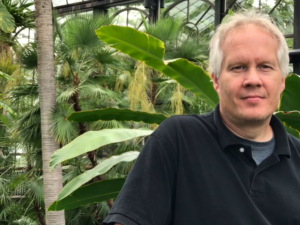
Kirk O’Riordan’s music has been referred to as “unapologetically beautiful” and is often praised for its uniquely “visual” qualities that depict a wide range of striking moods. His debut compact disk, Strange Flowers, was praised by Audiophile Audition as “one of the most impressive and beautiful collections of chamber music I have heard in awhile….This is all just so lovely and invokes exactly the emotions that good music should be able to induce in all of us.”Gramophone Magazine praised O’Riordan as “a composer for whom imagery is a defining inspiration.…[he] is a deeply sensitive composer who savours going gently into the night.” (April 2014). His recording of his Twenty-Six Preludes for Solo Piano—by pianist Holly Roadfeldt—has attracted similar praise: they “are similarly atmospheric and proceed to unfold like a magical tapestry. Each of the 26 Preludes seemingly comprising of warp and weft forming a myriad of pixels of little pictures that ultimately combines to form a moveable feast for both eye and inner ear. O’Riordan’s miniatures are informed by languorous beauty and profundity, the lyrical variations of each often feature elaborate embellishments, as well as sudden dissonant figurations that seem to mimic the gravity-defying leaps of the gazelle…” (World Music Report, April 2017)
His most recent release, Autumn Winds, has been similarly praised. “Compositionally it seems on first blush simple at heart but as one listens the details both flesh themselves out and freshen the listening mind so that it all seems increasingly evergreen and more complex than at first might be thought.” (Gapplegate Music Review, 2020) “[O’Riordan] is not strictly speaking a minimalist, yet he possesses that rare quality of capturing a vivid musical landscape with Webern-like efficiency.” (The Morning Call).
O’Riordan (b. 1968) is an active composer, conductor, saxophonist, and teacher. His music has been performed in Canada, China, Costa Rica, Cyprus, Finland, Italy, and Russia; and in nearly all of the fifty United States. In 2009 Dr. O’Riordan joined the faculty of Lafayette College where he serves as Associate Professor of Music and Director of Bands, teaching courses in music theory, and composition. In addition, conducts the Lafayette College Concert Band and Contemporary Music Ensemble. He holds the Doctor of Musical Arts degree from Arizona State University; the Certificate of Performance in Saxophone from Northwestern University; and three Master of Music degrees. Apart from his active teaching and composing schedule, Kirk is an avid fan of obstacle course racing.
Corey Beck ’22
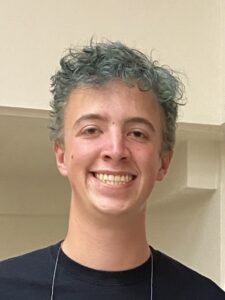
Corey Beck is a Senior Math and Physics Dual Degree at Lafayette College. Deeply involved in music on campus, Corey is the Assistant Conductor for Concert Band, Conductor for Pep Band, and Ensemble Assistant for Percussion Ensemble. Corey takes lessons with Dr. Kirk O’Riordan in conducting and Dr. Larry Stockton in percussion. With Dr. Stockton, Corey has also done study and research into non-Western music, particularly Japanese drumming traditions. Elsewhere on campus Corey is an executive board member of Alternative School Break, and is involved with Math Club, Women+ In Physics, and Physics Club.
About LCCB
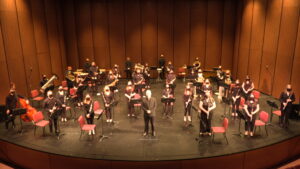
The Lafayette College Concert Band is comprised of approximately 50 students from a variety of majors who are united by a strong desire to perform the highest quality music at the height of their abilities. Participation in LCCB is open to students in any major as well as faculty and staff. The ensemble is conducted by Kirk O’Riordan, Associate Professor of Music.
LCCB typically performs one concert each semester. The repertoire is selected from traditional concert band masterpieces, newer works by established and emerging composers, commissions, and orchestral transcriptions. Past concerts have included works such as Husa’s Music for Prague 1968, Bernstein’s Symphonic Dances from West Side Story, both Holst Suites, Grainger’s Lincolnshire Posy, and Mussorgsky’s Pictures at an Exhibition. LCCB has premiered works by composer/conductor Kirk O’Riordan and 2010 Pesky Artist in Residence William Pfaff as well as Anna Zittle ’22, Justin Kogasaka ’22, Ashley Kushner ’19, and Zach Jones ’13.
Students enroll for 1/4-credit. Open to all students, faculty and staff, LCCB employs a wind ensemble model for instrumentation. A seating audition is required before the first semester of participation. Due to the large numbers of flutists, clarinetists, saxophonists, and trumpeters, the number of available seats in these sections is limited.
The Assistant Conductor Program
The Assistant Conductor program at Lafayette College is a unique opportunity for students to study conducting in an immersive, highly intensive environment. Open only to one or two students at a time, the program seeks highly advanced musicians who exhibit natural leadership potential and excellent musicianship. While serving as the Assistant Conductor, she/he conducts the ensemble on at least one piece in performance and lead all of the rehearsals for that performance. In addition, that person directs the Lafayette College Pep Band, the annual student-led musical, and will often conduct performances with other ensembles, such as the Percussion Ensemble and Contemporary Music Ensemble.
Students interested in becoming the LCCB Assistant Conductor study conducting for a year before assuming that role. In that time they develop their conducting, score study, and leadership skills as well as lead the Pep Band. By the time a student has completed their tenure in the position, she/he has accumulated a tremendous amount of podium time: more than almost any undergraduate conducting program in the country.
LCCB Assistant Conductors
Samantha Semsel ’25 (2023-2025)
Corey Beck ’22 (2021-2022)
Katie Rice ’21 (2019-2021)
Kyle Street ’19 (2018-2019)
Peri Chain ’18 (2016-2018)
Ryan Dupuis ’16 (2015-2016)
Sam Freiheiter ’15 (2014-2015)
Madeline Friese ’14 (2013-2014)
Alex Cutrone ’13 (2011-2013)
Blurred Days CD
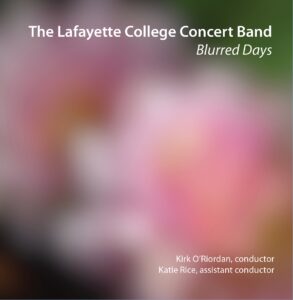 The LCCB Blurred Days CD is available for purchase ($20) in the lobby. Proceeds will support the J. Larry Stockton Music Scholarship Fund, which will provide funding for private lessons scholarships for Lafayette student musicians.
The LCCB Blurred Days CD is available for purchase ($20) in the lobby. Proceeds will support the J. Larry Stockton Music Scholarship Fund, which will provide funding for private lessons scholarships for Lafayette student musicians.
Like many bands and other performing ensembles across the country, we have had to adapt to the pandemic. For us, this has meant that we have not been able to work together, in person. This has always been a band that thrives on its sense of community, and not having that has been hard on all of us.
But rather than mourn what we have lost, we have searched for opportunities within our remote format that are unique. Working in isolation has allowed us to re-examine the possibilities of the Wind Ensemble as an entity—to re-imagine what is possible with this collection of sounds.
The five pieces on this CD were written especially for us, and especially for our situation. Each of the pieces was conceived to take advantage of techniques that would not be possible in a traditional concert—effects on a person-by-person level, or writing for flutes in their lowest register.
To make these performances, each student recorded his or her part on their phones or computers and uploaded them to either a shared drive or to the web-based recording service Band Lab. Katie Rice assembled the tracks and performed the first round of editing. I took the tracks she finished and combined them into the final product, completing the pre-production audio work.
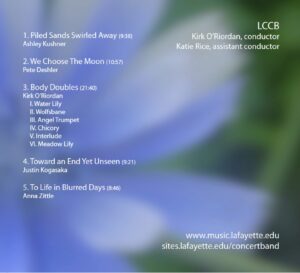 Every student has a unique track in the recording, which allows us to use studio effects on a person-by-person level. With many of the pieces, the individual parts were created to be non-linear—we could create specific sonic effects and duplicate them in the recording software. Several of the pieces incorporate improvisation, narration, and other unconventional techniques.
Every student has a unique track in the recording, which allows us to use studio effects on a person-by-person level. With many of the pieces, the individual parts were created to be non-linear—we could create specific sonic effects and duplicate them in the recording software. Several of the pieces incorporate improvisation, narration, and other unconventional techniques.
Our goal was to re-imagine what the wind ensemble could be under the conditions of remote instruction. I believe we have done that, and each composer solved that problem in wildly different ways. As conductor and professor, I am profoundly grateful to and proud of these students and what they have accomplished under very difficult circumstances.
Tracks:
1. Ashley Kushner: Piled Sands Swirled Away (9:37)
2. Pete Deshler: We Choose the Moon (10:51)
3. Kirk O’Riordan: Body Doubles (21:40)
I. Water Lily
II. Wolfsbane
III. Angel Trumpet
IV. Chicory
V. Interlude
VI. Meadow Lily
4. Justin Kogasaka: Toward an End Yet Unseen (9:24)
5. Anna Zittle: To Life in Blurred Days (8:48)
The Lafayette College
Department of Music
The Department of Music is dedicated to providing a dynamic, engaging, and challenging musical environment for all students, regardless of major. Our performance and academic experiences enhance the liberal arts mission of the College, enrich the cultural environment of the College community, and promote musical understanding through performance, historical and analytical study, and exposure to the diversity of musical expression.
We welcome all students who seek a rigorous and energetic study of music in a community-based, supportive environment. Music courses are available to any student, and many meet the College’s requirements for the Common Course of Study. Our ten ensembles are open to students in any major, and perform music from a wide array of diverse stylistic, cultural, and aesthetic traditions. Private lessons are available for beginners through advanced players and are taught by an exceptional applied faculty.
The Department of Music offers a Major (B.A.) and a Minor. Both programs are designed to easily combine with majors in other departments–this is very common with our students. We are dedicated to providing a wide variety of musical experiences for all interested students. We strongly encourage everyone to continue to build upon previous musical experiences and to develop new ones.
For more information: